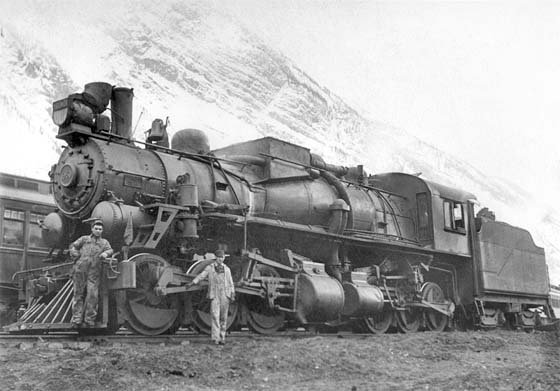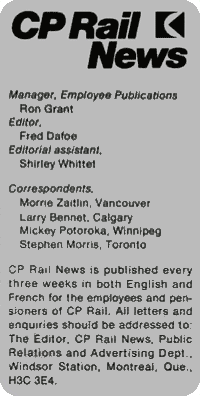
Number 3
February 27, 1980
A Turn-of-the-Century Glance

Sir, After reading CP Rail News dated 11 Jul 1979 and finding an article by Nicholas Morant with reference to Field, B.C., and the Field Hill, the man mentioned Mr. Ed McCombs. I must admit I never met him but I thought I would say the following:
My father was a shipwright, working in the River Clyde, and emigrated to B.C. to work in Vancouver at his trade. He eventually ended up building ships for the Canadian Pacific Railway at Nakusp. From there he joined the B&B gang at Revelstoke. He was caught in the big slide at Rogers Pass. (OKthePK Joint Bar Editor: The name McKenzie does not appear on the list of victims.)
I was hired as a callboy at Field, B.C., and was laid off each fall and re-hired each following spring until 1914 when the war broke out.
I then worked for Foley, Welch, and Stewart building the Connaught Tunnel. I was a flunky in the dining room first, then a plumber's helper, then I became an engineman on the engine that unloaded the rock from the tunnel. The engineer's name was Ed Kitelinger and the brakeman was Jim Garvin.
This was December, 1916 when I started as a wiper at Rogers Pass and my mate was Curly McLeod.
The men I remember from those days were Dan McLeod, Frank Cranston, Jim Warnock, and several others whose names escape me. I eventually married a Galt, Ontario, girl and spent five years at Field. In 1926 I moved to Revelstoke and in 1929, the Depression hit and most of our generation were hit hard.
Things began to pick up in 1939 and I was promoted to fireman and engineer during the war period.
I will deviate a little and mention Roxy Hamilton. In 1912 I was recalled as callboy at Field. I got room and board with Mrs. Hamilton. Her sister, Mrs. Gove, also lived there. I got to know Roxy and his frequent visits to the Monarch Hotel.
One thing I must emphasize is that the men working during this period were mostly boomers, the operators and switchmen were good railway men.
 I must mention the Hill train crew that was used exclusively for hill work. The first hill I can remember was Sam
Goalby's. At this time there was another run on oil shares in the Turner valley. When the slump came, Sam used the shares to paper the walls of
the caboose. The next name I can remember was Rorie McLennan, a Hill con, then the last one, Jack McComb. He later left for Calgary to go on a
passenger run.
I must mention the Hill train crew that was used exclusively for hill work. The first hill I can remember was Sam
Goalby's. At this time there was another run on oil shares in the Turner valley. When the slump came, Sam used the shares to paper the walls of
the caboose. The next name I can remember was Rorie McLennan, a Hill con, then the last one, Jack McComb. He later left for Calgary to go on a
passenger run.
MACHINES
There were mallet machines used on the Hill during the period 1950-1955. (OKthePK Joint Bar Editor: In 1917 all 6 Mallets were converted to 2-10-0 Decapods. The author may be confusing the Mallet's numbers. They were numbered 1950 to 1955 during the 1905 series.) When they were working they couldn't be seen for steam leaks. As one engineer who worked on this power said, you could pick huckleberries off the running boards when in motion.
I could mention lots of things that happened during the period 1911-1961 when I retired. The changed conditions along with the arrival of the diesels are unbelievable. I met many friends at the pensioners club in Toronto, many of them running trades who I enjoyed meeting.
A. McKenzie - Cambridge, Ontario.

